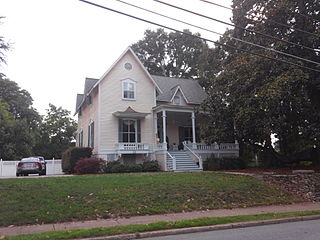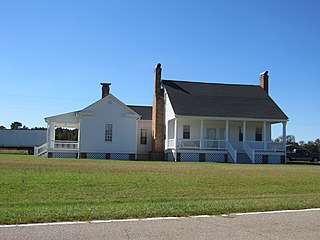
Ashe Cottage, also known as the Ely House, is a historic Carpenter Gothic house in Demopolis, Alabama. It was built in 1832 and expanded and remodeled in the Gothic Revival style in 1858 by William Cincinnatus Ashe, a physician from North Carolina. The cottage is a 1+1⁄2-story wood-frame building, the front elevation features two semi-octagonal gabled front bays with a one-story porch inset between them. The gables and porch are trimmed with bargeboards in a design taken from Samuel Sloan's plan for "An Old English Cottage" in his 1852 publication, The Model Architect. The house is one of only about twenty remaining residential examples of Gothic Revival architecture remaining in the state. Other historic Gothic Revival residences in the area include Waldwic in Gallion and Fairhope Plantation in Uniontown. Ashe Cottage was added to the Alabama Register of Landmarks and Heritage on August 22, 1975, and to the National Register of Historic Places on 19 October 1978.

The High Hampton Inn Historic District is a historic estate, resort, and national historic district nestled in the mountains of western North Carolina, in the Cashiers Valley in Jackson County, North Carolina. Originally the summer home of the prosperous Hampton family of South Carolina, the property was listed on the National Register of Historic Places in 1991.

Seclusaval and Windsor Spring is a historic property in Richmond County, Georgia that includes a Greek Revival building built in 1843.

The Baldwin-Coker Cottage is a historic house at 266 Lower Lake Road in Highlands, North Carolina. The Rustic-style 1+1⁄2-story log house was designed and built in 1925 by James John Baldwin, an architect from Anderson, South Carolina. The cottage is important as a prototype for a number of later houses that were built by members of the construction crew. The walls are constructed of notched logs, whose ends project at random-length intervals, both at the corners of the house, and from the interior, where logs are also used to partition the inside space. The house is topped by a side-gable wood shingle roof. The main gable ends, and the gables of the dormers, are clad in board-and-batten siding. A porch with naturalistic limb-and-twig railings spans the width of the main facade.

Biltmore Village Cottage District is a national historic district located at Asheville, Buncombe County, North Carolina. The district encompasses 14 contributing residential buildings in Biltmore Village. They were designed by Richard Sharp Smith and built about 1900 for George W. Vanderbilt. The dwellings are 1 1/2- to two-story, pebbledash finished half-timbered cottages with recessed porches, multiple gables, steeply pitched roofs, simple molded trim, one or more brick chimneys, and brick foundations.

It was listed on the National Register of Historic Places in 2006.

Robert Williams House is a historic home located near Eastover, Cumberland County, North Carolina. It was built about 1850, and is a 1+1⁄2-story Greek Revival style Coastal Cottage form dwelling. It has a gable roof with exterior end chimneys and features an engaged porch. Also on the property are the contributing smokehouse, original log corn crib, and a stable with loft.

Railroad House is a historic home located at Sanford, Lee County, North Carolina. It was built in 1872, and is a 1+1⁄2-story, three bay, board-and-batten, Gothic Revival style frame cottage. The gable roof has wide overhanging eaves and "rafter brackets." It has a one-story rear wing, a single central interior chimney in the main block, and an exterior end chimney at the rear of the wing. It was built by the Raleigh and Augusta Air Line Railroad for the depot agent. The house was moved to its present site in October 1962, across the street from its original location. The building is operated by the Railroad House Historical Association as a museum.

Caldwell-Cobb-Love House is a historic home located at Lincolnton, Lincoln County, North Carolina. It was built about 1841 as a transitional Federal / Greek Revival dwelling and extensively remodeled in the Victorian Cottage style about 1877. It was again remodeled and enlarged at the turn of the 20th century. The two-story, frame dwelling features three cross gable ells, wall dormers, inset porch, and balconies. It has a three-story rear wing. It was built by Dr. Elam Caldwell, a grandson of William Sharpe (1742–1818), a member of the Continental Congress.

Burras House is a historic home located at Jamesville, Martin County, North Carolina. It dates to the early-19th century, and is a 1+1⁄2-story, five bay, rectangular vernacular Federal style frame cottage. It has a gable roof and shed roofed front porch with vernacular, Doric order-type porch posts.

Roberson-Everett-Roebuck House is a historic home located at Robersonville, Martin County, North Carolina. It was built about 1900, and is a 1+1⁄2-story, Queen Anne style frame cottage. It has a steeply pitched hipped roof with central tower, lower cross gables, front porch, and a double-pile center hall plan. The house features decorative woodwork including exterior gable ornaments, bracketed cornices, and the front porch balustrade and spindle frieze. Also on the property is a contributing combination wood and smokehouse.

Pine Crest Inn is a historic resort inn complex located in Tryon, Polk County, North Carolina. The inn and three of the ten cottages were built in 1906 as the Thermal Belt Sanatorium for tuberculosis care. The 2 1/2-story inn and 1 1/2-story cottages are Classical Revival style frame buildings that feature pedimented gables and attached one-story shed porches supported by Tuscan order columns. The remaining cottages were built after the conversion of the property to an inn in 1917. Four of the cottages were built by Pine Crest Inn developer Carter Brown, and two are historic log cabins moved to the property from the eastern Tennessee mountains.

Mag Blue House is a historic home near Laurinburg, Scotland County, North Carolina. It was built in 1836, and is a 1+1⁄2-story, five bay by three bay, frame Coastal Cottage form dwelling, with Federal style decorative elements. It has a one-story gabled roof kitchen/dining room wing. It features a dominant gable roof that extends to shelter the full-width front porch, flush sheathing across the porch facade, and a hall-and-parlor plan.

Royal and Louise Morrow House, also known as Stone Cottage, is a historic home located at Brevard, Transylvania County, North Carolina. It was built in 1915, and is a 1+1⁄2-story, Bungalow / American Craftsman style stone dwelling. It has a steep, side-gable roof and three-bay wall dormers. Also on the property is a contributing garage.

North Carolina Agricultural Experiment Station Cottage, also known as College Station and Hezouri House, is a historic home located at Raleigh, North Carolina. It built in 1886 to house the residence and office of the North Carolina Agricultural Experiment Station, It is a two-story, frame farmhouse with elements of Gothic Revival, Italianate, and Queen Anne style architecture. It has a cross-gable roof and features sawnwork decoration on the front porch and gables. The building housed the first agricultural experiment station in North Carolina. The station closed in 1926, and it was subsequently used as a residence.

Perry-Spruill House, also known as Spruill House, is a historic home located at Plymouth, Washington County, North Carolina. It was built between 1882 and 1884, and is a 1+1⁄2-story, three bay, Gothic Revival style frame cottage. It has a high hipped roof with intersecting cross gables ornamented with inverted fleur-de-lys sawnwork, a full-width front porch, pointed Gothic windows, and is sheathed in weatherboard.

Vardell Family Cottages Historic District are three historic summer homes and national historic district located at Blowing Rock, Watauga County, North Carolina. They are Opicherhoka (1899-1900), Hemlock Cottage, and The Shoe (1933). Opicherhoka is a picturesque two-story, weatherboarded frame Arts and Crafts-style dwelling. Hemlock Cottage is a small rectangular, plainly-finished, weatherboarded, frame cottage. It consists of a two-story, two-room main block, a one-story shed roof front porch, and a gable roof ell. The Shoe is a small rectangular Arts and Crafts style one-story-with-loft frame cottage.

The former Randall Memorial Building, also known as the Village Cafe, is a historic commercial building located at Blowing Rock, Watauga County, North Carolina. It was built in 1907, and is a 1 1/2-story, weatherboarded cottage with steep gable roof. It has a one-story hip roofed wing. It was built by the local Episcopal Church congregation to serve as a workshop and training center for mountain handicrafts. It later served as a community centre.

Brown-Cowles House and Cowles Law Office, also known as the Paul Osborne House and Law and Bride Cottage, is a historic home and law office located at Wilkesboro in Wilkes County, North Carolina, United States. The Cowles Law Office was built about 1871, and is a small one-story frame building with gable roof and single-shoulder end chimney. The original section of the Brown-Cowles House was built about 1834, and enlarged with a two-story wing by 1885 and enlarged again between 1920 and 1926. It is a two-story frame dwelling with Federal style detailing. Also on the property are the contributing curing house and kitchen. It was the home of William H. H. Cowles (1840-1901), a lawyer and four-term Congressman during the 1880s and 1890s.

Dr. H. D. Lucas House was a historic home located at Black Creek, Wilson County, North Carolina. It consisted of two sections: a one-story Greek Revival style doctor's office built about 1850, and a late-19th century, Victorian cottage dated to the early 1880s, which served as Dr. Lucas' residence. The cottage was a one-story, three-bay, single-pile frame dwelling with a steeply pitched gable roof. The house has been demolished.




















